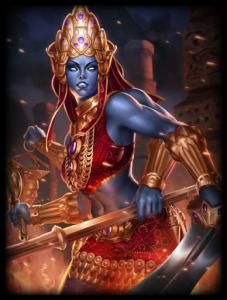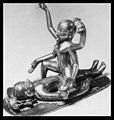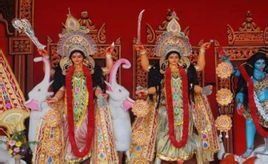起源
傳說有一天,三界中出現了一個法力強大的惡魔。這隻惡魔法力高強,它每滴一滴血在地上,地上就會出現一千隻和他一樣厲害的化身去遺禍人間。三大神之一濕婆大神的妻子——雪山神女帕爾瓦蒂得知訊息後大怒,就化身迦梨女神去消滅這頭惡魔。迦梨女神恐怕這頭惡魔會在決鬥的時候把自己的血滴在地上,使其出現一千隻法力同樣高強的惡魔化身,就先把它的血吸乾,一滴不剩。後來,迦梨終把這惡魔消滅,可是卻因為過於憤怒而不能自制,她的雙腳不由自主地大力踐踏土地,令三界眾生的生活都受到影響。其伴侶——濕婆為減輕眾生的苦痛,就躺在迦梨的腳下,任其踐踏以泄恨。這也是在印度教畫像或雕塑中,濕婆總是躺在迦梨腳下的原因。
 迦梨女神
迦梨女神迦梨在中古後期的孟加拉宗教文獻中同樣是一個中心角色,其崇拜者包括Ramprasad Sen(1718-75). 直到18世紀早期孟加拉式崇拜開始之前,由於不同於濕婆的配偶帕爾瓦蒂,卡利很少在印度神話和偶像描繪里被描繪為母親角色。
密宗方法接近卡利是在死夜的焚屍場上遇到卡利的勇氣,而不畏懼其恐怖面容。與密宗不同,孟加拉崇拜者採納了卡利的教會、接納兒童的態度。相同的是,他們都要尋求與死亡和解的方法,這在Ramprasad的作品中都有提及。
Ramprasad在他的一些其他詩歌中寫到,卡利不關心他的福祉,使他痛苦煎熬,讓他在塵世的享用和所得化為灰燼。他還寫道卡利的行為並不像一個母親,她也無視他的呼求:
仁慈何以尋諸於彼冰鐵之心?(將卡利引申為喜馬拉雅的女兒)伊豈有情,將橫踹神主之懷歟?吾母,人呼爾仁善,卻無點滴慈悲能查汝斷兒童之首,編之為裝飾之環千次呼汝“母親、母親”亦無益,汝必逆頸而忽略 因此Ramprasad強調,要做卡利的孩子,就要棄絕塵世的享樂。卡利並不會給與人們所要求的東西。對崇拜者來說,也許正是由於卡利女神拒絕賜予,她的崇拜者才會因此而對他們自己做出深層的反思並超越物質世界的誘惑。
詳細教義
迦梨的肖像
 Fig.C “迦梨和濕婆聯合
Fig.C “迦梨和濕婆聯合常見形象
Kali - Black Earth Mother, Conqueror of Time, Goddess of fertility, death and regeneration. Dark Mother, Hindu triple Goddess of creation, preservation and destruction. Birth and Death Mother. Treasure house of Compassion, Giver of Life to the World. Her mantras brought into being the very things whose names She spoke for the first time, Originator of the creative word or Logos. A triple Goddess - Maiden, Mother, Crone. Lady of the Dead. The Ocean of Blood at the beginning and end of the world. Also known as Jagadamba.
卡莉——黑色的地球母親,時間的征服者,豐產女神,死亡和再生。黑色的母親,印度三個一組(三位一體)的創造女神,保護和破壞。誕生和死亡的母親,憐憫的財富,世界的生命給予者。她的頌歌在每個生命裡面,她首先說它們的名字,創造性言詞或理則(道)的創造者,一個三位一體的女神——少女,母親和老太婆,死亡的女神,世界開始和終結的血的海洋,也被稱為傑加達巴。
From Wikipedia: Kali is a destructive and creative aspect of God as the Divine Mother in Hinduism.
卡莉是神毀滅性和創造性的面貌,是印度教的神聖母親。
Kali is the fierce aspect of Devi, God's energy, i.e., Shakti or God as the Divine Mother, who is fundamental to all other Hindu deities.
卡莉是朵維的兇猛外貌,神的能量,與薩克提或神一樣,是神聖的母親,是印度所有其他神的基礎。
The continuous, ongoing work of Creation is described as "the play of Kali".
持續的,正在進行的創世工作被描繪為“卡莉的遊戲”。
Kali is considered to be the destroyer of evil spirits and the preserver of devotees. [This brought voodoo to mind.]
卡莉是邪惡精神的毀滅者,也是皈依者的保護者。[這也帶來伏都教(巫毒教)的思想。
] She is the consort of Shiva. 她是濕婆的配偶。 Her name seems to be a female version of the word 'kala' (Sanskrit for 'dark' or 'time' - time in this form being a euphemism for death). It also means Black Female, in contrast to her consort, Shiva, who is white. [Yin/yang]
她的名字看來是“卡拉”(梵語的“黑暗”或“時間”——時間在這裡是對死亡的一種委婉說法)的陰性詞。它也是黑色女性的意思,與她的配偶濕婆相反,濕婆是白色的。[陰/陽]
Kali is the common name for Energy in her form as Shiva's wife, or Shakti.
卡莉是能量的普遍名字,她的形態是作為濕婆的妻子或薩克提。
Many people also believe her to be the same as Durga, even though this is not true as Durga is the terrible aspect of Devi, not the Shakti of Shiva. Other names are: Bhowani Devi, Sati, Rudrani, Parvati, Chinnamastika, Kamakshi, Uma, Menakshi, Himavati, Kumari. These names, if repeated, are believed to give special power to the worshipper.
很多人都相信她與杜迦女神一樣,甚至認為杜迦才是朵維恐怖的一面,而不是濕婆的薩克提。其他的名字是:布瓦尼朵維,薩提,魯達尼,帕娃蒂,支那瑪提卡,卡瑪克什,烏瑪,曼拿克什,喜馬瓦提,卡瑪里。這些名字,如果再三重複,據說會給予崇拜者特殊的力量。 Kali makes her 'official' debut in the Devi-Mahatmya, where she is said to have emanated from the brow of Goddess Durga (slayer of demons) during one of the battles between the divine and anti-divine forces. Etymologically Durga's name means "Beyond Reach". She is thus an echo of the woman warrior's fierce virginal autonomy. In this context Kali is considered the 'forceful' form of the great goddess Durga.
卡莉在朵維—摩訶瑪雅里“正式”登場,那裡說她是在一次神與反神力量的戰役中,從杜迦女神(魔鬼的宰殺者)的眉毛散發出來。“杜迦”這個名字從詞源學上意思是“延伸到較遠處”。她因此是女戰士的投射,兇猛的處女。在這篇文章里,卡莉被認為是偉大的杜迦女神的“有力”形態。
Skulls, cemeteries, and blood are associated with her worship.
頭骨,墓地和血與她的崇拜相連。
She is black and emaciated. Her face is azure, streaked with yellow, her glance is ferocious; her disheveled and bristly hair is usually shown splayed and spread like the tail of a peacock and sometimes braided with green serpents.
她是白色和虛弱的,她的臉是天藍色的,有黃色的斑紋,她的目光是兇惡的,她凌亂和如剛毛似的頭髮經常張開著,就像孔雀尾巴那樣地伸展,有時候辮成綠色的大毒蛇。
She wears a long necklace (descending almost to her knees) of human skulls. She may be shown wearing a girdle of severed arms. Children's corpses as earrings (likeliest representing natural infant mortality and childhood mortality from causes such as disease), and cobras as bracelets or garlands add to her terrifying adornments.
她戴著長長的人類頭骨項鍊(幾乎延伸到膝蓋)。她可能是展示出腰帶上的厲害武器。兒童的屍體是耳飾(很可能是代表嬰兒的自然死亡率和由某些疾病引致的兒童死亡),眼鏡蛇是手鐲,加在她身上的花環是極大的裝飾品。
Her purple lips are often shown streaming with blood; her tusk-like teeth descend over her lower lip; and her tongue lolls out. She is often shown standing on the inert form of her consort, Shiva. She is sometimes accompanied by she-demons. Her four arms hold weapons or the severed head of a demon: these objects symbolize both her creative and her destructive power, for Kali personifies the ambivalence of deity, which manifests itself, according to Indian tradition, in the unceasing cycle of life and death, creation and destruction.
她的紫色嘴唇經常表現出血液的流動;她長牙狀的牙齒下降到她的下唇上;她的舌頭伸出外面。她經常站在她的配偶,無活動性的濕婆上面。她有時候陪伴著魔鬼。她的四臂握著武器,或者嚴厲的魔鬼的頭;這些物品既象徵著她創造性的力量,也象徵著她毀滅性的力量,因為卡莉使正反感情並存的神性人格化,顯示出它自身,依照印度教的傳統,是生命與死亡,創造與毀滅的不斷循環。梵文Kali意為“黝黑的”迦梨女神是印度教神話中濕婆之妻女神提毗(或難近母)的異體之一,被視為濕婆的“薩格蒂”(神聖動力)之破壞範疇的化身;又稱“時母”。據說,劫末之時迦梨女神將以黑暗籠罩寰宇,促使其歸於毀滅,因而又稱“迦羅羅陀利”(意即“時光之暗夜”)。對迦梨女神的崇拜,溯源於非雅利安人,同所謂血祭不無關兩,同正統的印度教大相逕庭,在性力派的信仰中卻居於至關重要的地位。孟加拉地區將迦梨女神奉為降魔者和有強大威力的保護神。
宗教祭典
2015年6月23日,印度古瓦哈蒂,四面八方的教徒齊聚Kamakhya寺廟,慶祝迦梨女神節(Ambubachi Festival)

